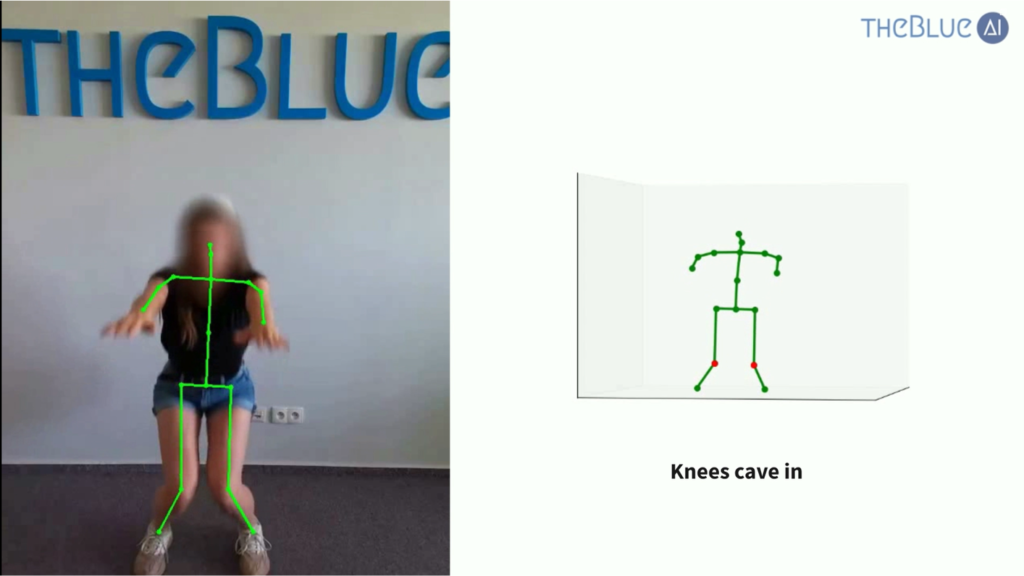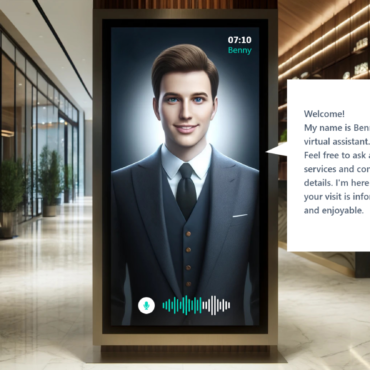Revolutionizing Movement Analysis with 3D Movement Recognition: A Versatile Technology by theBlue.ai
In the fast-paced landscape of modern business, companies across various sectors often share a common objective: the pursuit of efficiency and performance optimization. However, achieving these goals can be challenging, especially when it comes to identifying areas that require enhancement and deploying the right technological solutions to address them. As companies strive to stay competitive and adaptive amidst evolving market dynamics, the critical requirement emerges for solutions that shed light on avenues for enhanced efficiency.
In this article, we take a closer look at 3D Movement Recognition. We’ll break down the technology itself and explain how it works in a way that’s easy to grasp. We’ll also explore different ways to use it, including camera setups and point cloud methods. This technology isn’t just a fancy gadget; it’s a practical tool that can improve efficiency in various aspects of a company’s operations. By the end of this article, you’ll have a solid understanding of 3D Movement Recognition, how it can be applied, and the benefits it brings to your business.
Discover how 3D Movement Recognition empowers companies to uncover hidden opportunities for efficiency enhancement and performance optimization, and more. As we explore its capacity to revolutionize operations, drive cost savings, and elevate competitiveness in a rapidly evolving business landscape, we’ll also delve into a selection of compelling use cases, showcasing the tangible impact of this technology in diverse industries.
What is 3D Movement Recognition, and why is it needed?
3D Movement Recognition, also known as 3D Movement Analysis, is a method tailored to scrutinize human and machine movements within three-dimensional space. Its main role extends beyond mere motion observation, aiming to dissect intricate of movement patterns, evaluate the effectiveness of specific motions, and reveal interesting insights.
This technology finds its relevance and importance in its versatile applications across industries. 3D Movement Recognition optimizes processes, increases performance, reduces the risk of injuries, and reveals potential hazards in various environments.
It equips businesses with the means to not only understand the intricacies of movement but also leverage them for improved efficiency, safety, and overall performance. Through this lens, the world of motion transforms into a realm ripe with opportunities for progress and enhancement.
In fact, it has numerous applications, making it an invaluable tool in various sectors. Let’s explore some of these practical scenarios where this technology makes a significant difference.
Illustrating the Potential: 4 Application Examples
The following use cases highlight the technology’s wide-ranging potential, showcasing its ability to address specific challenges and optimize various tasks and scenarios across different sectors:
1. Elevating Golf Performance through Posture Analysis and Real-time Error Correction
Within the world of golf, precision and form are paramount. 3D Movement Recognition, offering golfers the invaluable advantage of real-time posture detection and error feedback. As golfers swing, this technology analyzes their posture and swing mechanics, providing immediate feedback. This enables golfers to spot and rectify errors, refining their skills and achieving peak performance. While this example focuses on golf, it’s worth noting that this versatile technology can similarly enhance performance in various other sports.
2. Addressing Challenges with an Intelligent 3D Personal Trainer
In various professional contexts, personnel shortages can pose challenges in delivering tailored care and optimizing performance. Leveraging 3D Movement Recognition alongside a digital personal trainer equipped with pose correction capabilities emerges as a powerful solution. It offers personalized exercise guidance and support, efficiently addressing workforce shortages and ensuring individuals receive the specialized care and assistance they require. This can manifest as fitness center trainers, athletic coaches, rehabilitation specialists/physiotherapists, and more.
3. Ensuring Well-being through 3D Movement Recognition
Safety is paramount across a spectrum of settings, spanning medical facilities, homes, and public places. Within these diverse environments, the effectiveness of 3D Movement Recognition in promptly identifying and mitigating potential risks is noteworthy. This technology can also detect hazards such as falls, seizures, and harmful movements, facilitating swift interventions to safeguard the well-being of all individuals within the surroundings. For example, in specialized facilities, it can play a crucial role in the timely recognition and response to epilepsy seizures, further enhancing safety protocols.
4. Safeguarding and Streamlining Industrial Operations
In industrial environments such as warehouses and construction sites, precision and safety are of utmost importance. 3D Movement Recognition can perform the task of meticulously tracking and analyzing both human and machine movements. It possesses the capability to enable precise detection while optimizing workflows. Through its ability to minimize accidents and errors, this technology not only enhances safety but also elevates overall operational efficiency.
These application examples underscore its multifaceted capabilities across diverse sectors, demonstrating that the technology can be customized to suit specific scenarios, effectively addressing unique challenges, and optimizing a wide range of tasks. It is important to note that this solution is not an ‘off-the-shelf’ product, but rather a solution that is developed and adapted to meet the unique needs of each client.
The Technology Behind 3D Movement Recognition – Why 3D?
To better understand movements within three-dimensional space, this technology employs a variety of approaches for meticulous capture and analysis. These diverse methods are strategically chosen based on specific needs, covering a wide range of scenarios. Here are the primary methods utilized:
1. Single RGB Camera
This approach adopts a three-step detection process. Initially, it detects people within the image. Subsequently, it isolates the region containing the detected person and passes it through a 2D keypoints detection model. This model returns coordinates of keypoints in pixels, signifying their positions on the image. The final step involves converting these 2D keypoints into the 3D space using another AI model. While this method offers valuable insights, it does entail some degree of estimation, particularly when body parts are occluded or not visible due to the single image perspective.

2. Multiple RGB Cameras
In contrast, the Multiple RGB Cameras setup enhances accuracy by leveraging the perspectives of multiple cameras. Camera calibration establishes their spatial relationships, enabling the fusion of views. Two primary approaches can be employed. First, a dedicated AI model processes input images from all cameras along with calibration data to produce 3D keypoints and person detection. However, it requires training with 3D keypoint data, which can be challenging. Alternatively, a 2D keypoint detection model can be used, allowing for manual data labeling. A triangulation process connects these 2D keypoints to derive 3D poses, though accuracy depends on the precision of the 2D keypoint detection model. The choice between these approaches depends on specific project requirements and constraints.
3. Single Depth Camera
The Depth camera (e.g. Kinect), on the other hand, possesses a distinct capability. It can capture both RGB frames and depth frames. By emitting a signal that bounces off obstacles and returns to the camera, it calculates the distance to the obstacles. This process creates a depth image, eliminating the need for guesswork in 3D keypoint detection. With depth information readily available, a dedicated model designed for depth cameras can accurately detect and provide information about a person’s 3D keypoints.
4. Multiple Depth Cameras
Similar to the single-depth camera setup, multiple-depth cameras offer the advantage of accurate depth information. However, with 3D keypoints obtained from different views and the accompanying calibration data, a unique advantage emerges. It becomes possible to average the 3D positions of keypoints, enhancing accuracy further. This averaging process benefits from a multi-perspective view, providing a more robust understanding of the pose from various angles.
5. 3D Point Cloud
The 3D Point Cloud technology serves as a versatile digital representation of physical spaces or objects, offering adaptability to an extensive array of scenarios. Its applicability extends across multiple sectors, and the selection between Time-of-Flight (ToF) sensors or photogrammetry depends on specific needs. ToF sensors excel in scenarios requiring precise distance measurements over short ranges, while photogrammetry shines in capturing 3D data from diverse angles, catering to multifaceted spatial requirements.
The potential of 3D Point Cloud technology is exemplified in its ability to create a 3D digital twin, offering precise insights into your facility. This technology can enable for example the analysis of operations and activities, identification of bottlenecks, and the opportunity to enhance operational efficiency in businesses or clinics.

In essence, the diverse approaches within 3D Movement Recognition are finely tuned to the unique demands of each scenario, underscoring the technology’s adaptability and efficacy in addressing an array of challenges across various sectors.
Business Benefits of Using 3D Movement Recognition
- Enhanced Precision: 3D Movement Recognition delivers unmatched precision in tracking and analyzing movements, offering valuable insights.
- Injury Prevention: By identifying inefficient or potentially harmful movement patterns, this technology contributes to injury prevention.
- Real-time Insights: Users receive immediate feedback on their movements, facilitating instant adjustments and improvements.
- Operational Efficiency: In professional environments, precise tracking of movements optimizes operations, reducing errors and boosting efficiency.
- Safety Enhancement: 3D Movement Recognition can play a role in detecting and averting potential hazards, promoting safety across different sectors.
This technology, with its diverse methods and approaches, stands ready to cater to the unique requirements of a multitude of industries and use cases. No matter the scenario, from healthcare to entertainment, from manufacturing to sports analysis, 3D Movement Recognition can be meticulously customized to serve as the ideal solution.
Customized 3D Movement Recognition-Solution for Your Needs
At theBlue.ai, we specialize in developing scalable deep tech and AI solutions that drive digital transformation and elevate operational efficiency. With a wealth of expertise in Artificial Intelligence, Machine Learning, and Deep Learning, our dedicated team is committed to helping our clients succeed in today’s rapidly evolving landscape.
Ready to enhance your operations with our 3D Movement Recognition technology?
You have your own idea? We bring your vision to life! Contact us today to start the journey toward a solution tailored to your needs.





